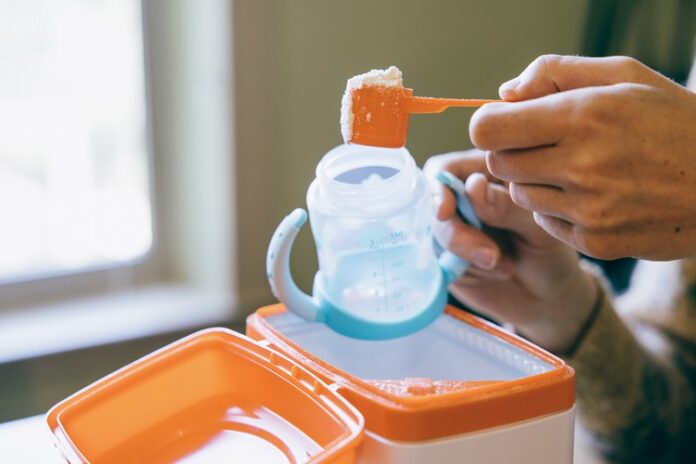In the first year of life, a baby undergoes monumental physical and cognitive growth. This pivotal period necessitates optimal nutrition, and for many parents, this means choosing the right baby formula. While breastfeeding offers a natural nutrition source, there are various reasons a parent might opt for or supplement with formula. As the backbone of a baby’s nutrition when breast milk isn’t exclusively used, selecting the right formula is vital. This guide will shed light on how to navigate the myriad choices and find the perfect fit for your little one’s dietary needs.

Understanding Baby Formula Types
The market is saturated with different baby formulas, each tailored to unique requirements. Here’s a deeper dive:
Cow’s Milk Formula: The standard choice for many, it mirrors breast milk’s consistency, albeit modified for easier digestion and fortified with necessary vitamins and minerals.
Pros: Widely available, nutritionally complete for most babies.
Cons: Potential allergenic properties may not suit babies with lactose intolerance.
Soy-based Formula: A lifesaver for babies unable to tolerate lactose or for families who follow a vegetarian lifestyle. It’s derived from soybeans and tailored to provide full nutrition.
Pros: Vegetarian-friendly, bypasses lactose-related issues.
Cons: Potential allergenic properties related to soy, not recommended for premature babies.
Hydrolyzed Formula: The proteins here are broken down into simpler forms, making them easier on a baby’s digestive system.
Pros: Hypoallergenic, ideal for babies with a family history of allergies or those with diagnosed protein allergies.
Cons: Pricier than other options, might have a taste that some babies reject.
Navigating these options can be overwhelming, but remembering that each formula type has been designed with specific babies in mind can help parents zero in on the right choice.
Pediatrician Consultation
Seeking professional advice is crucial. A pediatrician’s guidance is invaluable in determining the best formula for your baby. Pediatricians can evaluate factors like weight, growth patterns, and any signs of allergies or sensitivities. When preparing for the consultation:
Track your baby’s feeding routines, noting any reactions post-feed.
Be aware of family medical history, especially regarding allergies or intolerances.
Jot down your queries about specific ingredients, formula types, or brand recommendations to make an informed decision.
The goal is to align your observations with the pediatrician’s expertise for the best outcome.

Assessing Your Baby’s Needs
Every baby is an individual with distinct needs. When assessing the right formula:
Allergies and Sensitivities: Be vigilant. A family history of food allergies might mean your baby is at a higher risk. Take note of any unusual reactions after feeding – rashes, excessive fussiness, or unusual bowel movements.
Dietary Needs: Some babies might need more iron, while others might require specialized formulas due to medical conditions.
Digestive Health: Pay attention to how your baby is digesting the formula. Consistent issues might indicate the need for a switch.
Reading Labels and Ingredients
Navigating the formula aisle might feel like decoding a foreign language. However, understanding labels and ingredients is crucial for your baby’s health and well-being.
Primary Ingredient: This will indicate the base, be it cow’s milk, soy, or another source.
Added Nutrients: Look for essential additions like DHA and ARA (fatty acids), iron, and other vitamins. These enhance cognitive and physical development.
Sugars: Lactose is the primary sugar in many formulas. Be wary of those with added corn syrup or other sugars.
Additives: Some formulas boast probiotics for digestive health or other specialized ingredients.
Expiration Date: Always ensure the formula hasn’t expired to guarantee its nutritional integrity.

Age-Appropriate Formulas
Formulas aren’t one-size-fits-all. As your baby grows, their nutritional requirements evolve.
Newborns to 12 months: Infants require nutrient-dense formulas tailored for rapid growth.
Toddlers (12 months and beyond): As they venture into solid foods, their formula might need to supplement nutrition, focusing more on iron or even serving as a milk substitute for lactose-intolerant toddlers.
Specialized Needs: Premature babies or those with specific medical conditions might need tailored formulas even beyond the toddler years.
Regularly evaluate your formula choice, even if it’s a good one like Holle Formula, to ensure it aligns with your child’s developmental stage.
Formula Preparation and Storage
Safety and hygiene are paramount when preparing baby formula.
Boiled Water: Use freshly boiled water and let it cool slightly before mixing.
Correct Measurements: Always adhere to recommended ratios to ensure your baby is getting the right nutrition.
Storage: Prepared formula should be consumed quickly. If storing, refrigerate immediately and use within 24 hours.
Cleaning: Sterilize bottles, nipples, and all preparation equipment regularly.

Signs of Allergies or Sensitivities
Your baby might not always verbally communicate discomfort, but signs will manifest. Watch out for:
Digestive Issues: Diarrhea, constipation, or excessive gas.
Skin Reactions: Hives, rashes, or eczema can indicate an allergic reaction.
Respiratory Problems: Wheezing or constant congestion post feeding.
Behavioral Changes: Increased fussiness, or visible discomfort during or after feeds.
Always consult your pediatrician if you suspect an allergic reaction or sensitivity. Timely intervention can prevent complications.
Monitoring Your Baby’s Growth
Tracking growth is crucial to ensure that the formula is adequately nourishing your baby.
Regular Check-ups: Pediatricians will measure weight, length, and head circumference. Consistent growth within recommended percentiles indicates good health.
Developmental Milestones: Monitor cognitive and physical milestones. Delays might necessitate a reevaluation of nutrition.
Staying proactive and observant ensures your baby thrives on their formula.

Mixing Breastfeeding and Formula Feeding
Combining breastfeeding with formula, or “combo-feeding,” can be an excellent solution for many families.
Balancing Act: Ensure your baby is still receiving essential nutrients from both sources.
Supply Maintenance: If breastfeeding, maintain your supply through regular pumping or feeding.
Consistency: Stick to a feeding routine, adjusting based on your baby’s hunger cues and growth needs.
Remember, there’s no one-size-fits-all approach. Find a balance that caters to your baby’s unique requirements.
Transitioning to Solid Foods
Around the 6-month mark, many babies show interest in solids.
Gradual Introduction: Start with single-ingredient purees, noting any allergic reactions.
Formula as a Base: You can mix formula with cereals or purees initially, ensuring a familiar taste while introducing new textures.
Balanced Diet: Even as solid foods become a mainstay, ensure your baby gets essential nutrients from formula or breast milk.
Transitioning is a journey; savor each new discovery with your little one.

Conclusion and Resources
Choosing the right formula and navigating feeding challenges are parts of the profound journey of parenthood. Remember, every baby is unique; what works for one might not for another. Stay informed, trust your instincts, and consult with healthcare professionals when in doubt.









